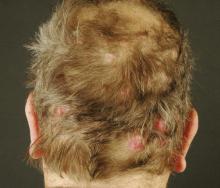ORLANDO - Surgical excision is the preferred approach for treating a patient who presents with a cylindroma or with the more extensive familial cylindromatosis, Dr. Leonard Slazinski said.
There are some important distinctions between the two. Cylindromas are benign skin appendage tumors that commonly present as single, slow-growing lesions on the head and neck. Lesions often appear in conjunction with spiradenomas and trichoepitheliomas, they typically are 0.5-6.0 cm in size (although some can grow larger), and they affect females more than males. They arise sporadically with no known inheritance pattern.
The tumor can be excised with careful inspection to ensure removal of all tissue, Dr. Slazinski said. "In my experience, the cylindroma often does have a pseudocapsule, which allows for blunt dissection of the tumor under direct vision."
In contrast, familial cylindromatosis is an inherited autosomal dominant condition characterized by multiple lesions located on the head and neck. Treatment is trickier, as there is no effective field or systemic therapy. Surgery should be considered most effective, but many doctors "are overwhelmed by the number of these lesions," said Dr. Slazinski, a dermatologist in private practice in Sarasota, Fla.
Familial trichoepitheliomas, Brooke-Spiegler syndrome, and familial cylindromatosis share a genetic etiology – a mutation of the CYLD gene on chromosome 16. "Great advances have been made in etiology and cellular mechanisms of familial cylindromatosis and related conditions," Dr. Slazinski said. But "treatment has not advanced to the same degree."
Removal of these lesions is often performed for aesthetic and functional reasons. "These diseases can become quite severe if untreated," Dr. Slazinski said. The psychosocial impact can be great, and patients often become social recluses.
Even with traditional excision, recurrence "is quite high" at approximately 42%, Dr. Slazinski said. Mohs micrographic surgery is used more often for solitary lesions. Other options, depending on the individual presentation, include cryotherapy, curettage, electrosurgery and radiofrequency excision, and true scalp excision with split-thickness grafting, "which is advocated in severe cases."
Cylindroma patients often present with pseudoalopecia because the tumor does not grow hair. Scalp cylindromas present a unique challenge, with limited tissue and patients’ desire to spare their hair, Dr. Slazinski said. "Hair cosmesis is often the patient’s greatest concern. Paradoxically, as hair is conserved, [the area] can become a reservoir for future tumor formation."
Some clinicians advocate topical aspirin therapy for familial cylindromatosis, Dr. Slazinski said. There may be "less than stellar results, but my patient is seeing some benefit and wants to continue on compounded, topical salicylic acid."
Dr. Slazinski described a patient with an extensive number of lesions across her face, head, and neck. "I'm blessed to be able to take care of this patient, because no one else has really offered her any possibility of improvement. I’ve taken it on myself to at least try to palliate the situation. I am under no delusion that I can cure her in any way."
Dr. Slazinski said he had no relevant financial disclosures.


